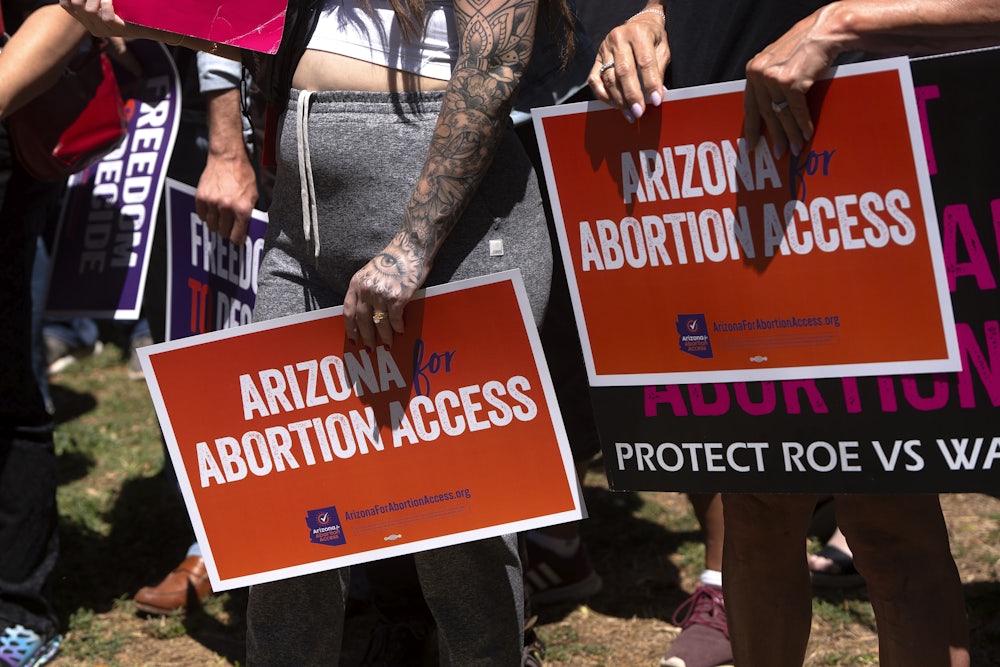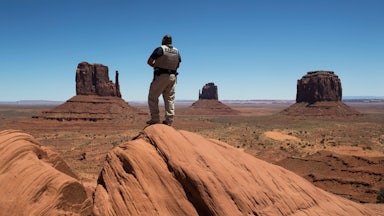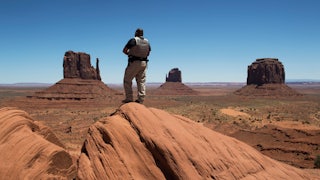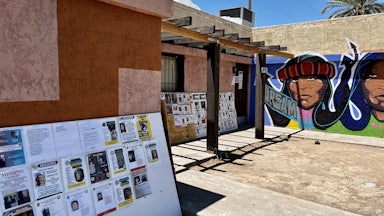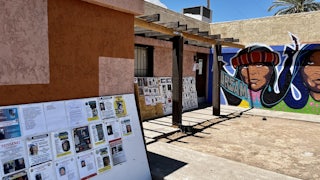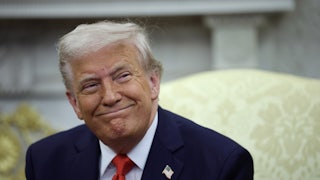About 30 years ago, doctors in an Indian Health Service clinic in Tuba City, Arizona, told Jamescita Peshlakai that her health would be at risk if she continued her pregnancy. Peshlakai, who is a citizen of the Navajo Nation, had given birth before; her young daughter was a toddler. But this second pregnancy was nonviable, meaning that the fetus would not survive outside of the uterus. The physicians performed a dilation and curettage procedure, commonly known as a “D&C,” to remove the fetal tissue.
“It was nobody’s business,” Peshlakai, now 56, recalled. “I did that, and I didn’t think twice about it, and it was my own decision with my family.”
Peshlakai, the descendant of medicine men and women, learned afterward about traditional methods used by the Navajo centuries before to terminate a pregnancy. She sees abortion as a part of her people’s history, and argues that views opposing the procedure were introduced with the morality circumscribed by the Christian church.
“When people were being hunted by the U.S. cavalry, and you were hiding with your children, you had to keep the ones that were alive, alive,” Peshlakai, a former state senator, said. “Women practiced in secret ceremonies to do this kind of thing. It was handed down.”
Despite this history, it can be difficult to talk about abortion on the reservation, given the traditional stigma surrounding the topic in American life. But in the two years since the U.S. Supreme Court overturned Roe v. Wade, abortion access has become a ubiquitous topic in Arizona, where the state legislature narrowly voted to repeal a nineteenth-century near-total ban that was on the books. Arizona currently prohibits the procedure under most circumstances after 15 weeks of pregnancy.
An initiative on the ballot this November, Proposition 139, would allow for abortions through fetal viability, generally around 24 weeks of pregnancy. Jaynie Parrish, the executive of Arizona Native Vote, a Native voter-engagement organization that supports Proposition 139, said that local community matriarchs had expressed support for abortion access in small group meetings. These conclaves include respected elders from Navajo, Hopi, and White Mountain Apache tribes.
“They’ll look around, maybe, but they’ll be like, ‘Of course it’s our decision. It’s no one else’s.’ … And then we start getting into the deeper conversations about shaming and judging,” Parrish, who is Navajo, said. “It’s been so taboo for so long, the way it’s been framed, and it’s going to take some people some time to shed that.”
Abortion access may be a critical issue for Navajo voters in Arizona as they consider their options on a state and federal level this November. Democrats argue that abortion is also on the ballot with their candidates, with Vice President Kamala Harris, the party’s nominee for president; Representative Ruben Gallego, who is seeking to become Arizona’s next senator; and Jonathan Nez, the former president of the Navajo Nation who is running for the congressional seat that encompasses much of the tribe’s territory.
History has a way of rhyming. The year that the near-total ban was enacted in the then-territory of Arizona, 1864, was the same year that the U.S. government forced the Navajo people to march from their ancestral homelands to internment camps in eastern New Mexico. Navajo supporters of abortion see a connection between previous federal efforts to interfere in Native life—from forced removal to sterilization—and attempts to limit access to reproductive health care.
“When [abortion is] restricted, when it’s limited, when it’s taken away, that’s not tribal sovereignty,” said Allie Young, a Navajo grassroots organizer who founded the Indigenous civic engagement program Protect the Sacred. “It’s really important for our Native women, just because of the history of our country and the many things that have been taken away from us as Indigenous peoples—from the actual and cultural genocide that takes place in this country, to the forced sterilization of our women.”
There are 22 federally recognized tribes in Arizona, with roughly 6 percent of the state population identifying as Native. At around 461,000 people, Arizona’s Native American population is the third-largest in the country. The majority of Arizona Natives are Navajo, or Diné. The Navajo Nation is the most populous tribal nation in the United States, as well as the biggest geographically. It stretches across three states—Utah, Arizona and New Mexico—although the majority of the territory lies in northeastern Arizona.
Native voters are considered an important demographic within this critical swing state; their votes helped ensure President Joe Biden’s narrow victory in Arizona in 2020. The Arizona counties that include portions of the Navajo Nation are not politically monolithic, with Navajo County—which also covers a large part of Hopi tribal lands—reliably voting more conservatively than neighboring Coconino and Apache counties.
Vice President Kamala Harris’s campaign has launched ads on tribal radio and TV stations targeted at Native voters living in and around the Navajo Nation, and her campaign touts nearly 30 full-time staff focused on tribal communities throughout the state. The Republican Party has also invested in reaching out to Arizona Natives, including with ads targeted at Navajo voters.
According to an analysis by Votebeat, around 71,000 voting-age Arizonans speak Navajo, including one in 10 who are not fluent in English. There is no specific word in Navajo for abortion, which has complicated the translation of the initiative for Navajo-language ballots and also made it difficult to communicate effectively about what it will do.
Liv Knoki, the executive director of Wingbeat 88, a nonpartisan organization focused on Native voter engagement that has not taken a specific stance on Proposition 139, said that the language around abortion could be influenced by the beliefs of the translator. A Christian Navajo may use “harsh words” to frame abortion, describing it in terms of “death and killing,” Knoki said.
In the nineteenth and twentieth centuries, Catholic and Protestant missionaries undertook significant efforts to convert members of the Navajo Nation; today, many Navajo identify as Christian. Navajo Christians may, in turn, tend to be more socially conservative, in line with the mores of their faith tradition. The bishop of the Catholic Diocese of Gallup, which encompasses Navajo lands, recently joined a statement with other Catholic bishops in Arizona expressing strong opposition to Proposition 139.
The political fight over abortion access can feel like an imposition of a Western argument. Knoki said that she believed it was important to consider abortion through an “Indigenous lens” that emphasized the role of “traditional midwives who take care of mothers across a whole gestational process.
“I think it helps to talk about those things in those terms rather than just focusing on … the Westernized belief of what abortion is,” Knoki said. “I think it’s important to have these conversations, insofar as we’re challenging our people to look at abortion through the lens of our Indigenous knowledge and ways.”
Clara Pratte, the chair of the Native American Caucus for the Democratic National Committee, said that “most Native voters would say that they consider themselves very much pro-life” but that framing abortion access in terms of “bodily autonomy” connected with people living on tribal lands. “The government doesn’t need to be making these decisions for us, and health care shouldn’t be mandated by a bunch of politicians,” Pratte, who is Navajo, said.
There are also cultural considerations. Parrish, who is on the board of the Planned Parenthood Advocates of Arizona, said that conversations about abortion within Indigenous communities in the state may occur in more private settings and emphasize the importance of privacy. “It’s going to be very different from the way Planned Parenthood will frame things and say it,” Parrish said. “It’s very much, ‘You don’t get to tell us what to do in our families.’”
Native Americans living on tribal lands have never had easy access to abortion. Indian Health Service clinics are largely unable to provide the procedure thanks to the Hyde Amendment, a 1976 law that prohibited federal funds from being used for abortion except in cases where continuing the pregnancy would endanger the life of the mother. Moreover, some reporting suggests that most IHS facilities do not keep mifepristone, a key abortion medication, in regular stock.
Steady access to reliable health care, including obstetric care, is already a challenge for Indigenous women, as many reside in rural areas. One recent report found that Indigenous women and women living in tribal territories in Montana were more likely to bypass their local health facility when giving birth than white women and that they had longer distances to travel. Another study found that incidence of severe morbidity and mortality was nearly twice as high for Indigenous women as for white women. Even if Proposition 139 is approved, the strictures of the Hyde Amendment would still apply; the removal of those restrictions would require congressional action. However, they would be able to travel off of tribal lands to obtain an abortion, even if it could not be easily accessed in an Indian Health Service clinic.
Some see a connection between the struggles that Native women face in obtaining adequate maternal health care and the movements highlighting missing and murdered Indigenous women, or MMIW, and missing and murdered Indigenous people, or MMIP. Indigenous women face disproportionately high rates of violence, including homicide and rape.
“It’s already hard to report issues of abuse, and abortion is the last option. [Abortion opponents] make it seem like a stamp-card kind of situation,” said Ayden Clytus, a young Diné woman now living in Phoenix. “So not only do we have higher rates of sexual crime, our health care systems are underfunded—significantly underfunded—in Indigenous communities.”
Where Peshlakai represents an older generation of respected matriarchs, Clytus at 22 years old is in the new vanguard of Native women willing to speak about abortion more openly. (Parrish recruited both Peshlakai and Clytus to write op-eds in support of Proposition 139 for Arizona Native Vote, and Peshlakai has also recorded ads for local radio endorsing the initiative.) Clytus said that while many older Navajo people were raised in the church, members of her generation often distanced themselves from Christianity as they left the reservation. She believes that the issue of abortion may be motivating for younger Navajo women, even as older generations remain skeptical.
Regardless of how Navajo voters will take abortion access into account on Election Day, intra-community discussions on the topic are not going away. Knoki said that she wanted to encourage conversations about maternal health care from “before hospitals, before IHS, when we were giving birth in our hogans,” referring to traditional Navajo homes. “How do we just take care of ourselves and our community members, as opposed to what is another system of thought or organization that is trying to—not coerce on us, but invite us into their space about how they think and feel about these things?” Knoki said.
She continued: “Rather than fighting amongst one another, and saying, ‘You’re not traditional,’ or ‘You’re Christian,’ how do we respect that we are all Navajo, respect that we’re all Indigenous?”
